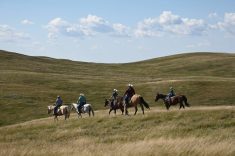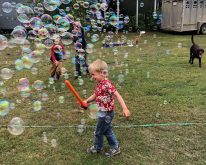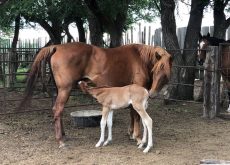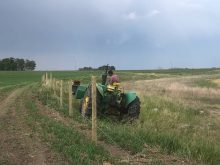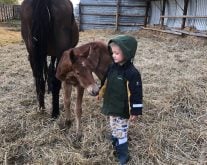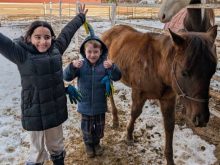The worst accidents seem to happen when you least expect them.
I was riding with my dad, just tootling around the pasture, on the September long weekend. He was riding a palomino mare that I’d started for him. My gelding, Bear, is still a little green, but was quite well-behaved that day.
Overall I’d been happy with Bear’s progress over the summer. He’d tried crow-hopping once or twice, but had given up easily. He’d even held steady when we’d encountered a bunch of black bears earlier in the year.
Read Also

How we combine stock and option strategies
Options can enhance an investor’s returns — but should only be considered after significant and successful experiences with stocks, including a vicious bear market, Herman VanGenderen writes.
As we rode back to the tack shed, I dismounted to open and close a gate. And as I put my foot in the stirrup, I made a sloppy mistake. Bear started to walk off, following my dad’s horse. Usually I don’t let horses walk away while I’m mounting, as it’s an annoying, and potentially dangerous, practice. But that day I just swung up, thinking I would stop him once I was in the saddle.
Before I could get my right foot into the stirrup, Bear shifted into a lope. I was annoyed at his bad behaviour, but not worried. The last thing I remember is trying to wiggle my right foot into the stirrup and tightening the reins to slow him down.
Then I woke up on the ground.
The anatomy of a memory
Before you can transfer a short-term memory into the long-term memory vault, your brain needs to undergo chemical and physical changes. If something — such as getting knocked out — disrupts those changes, the information isn’t transformed into a long-term memory. If the areas in the brain that do this work are severely swollen or injured, long-term memory problems can linger after the accident.
It’s not unusual to suffer some sort of memory loss after a concussion. People have been sharing their head injury stories with me the over the last few weeks. One person told me about losing two-and-a-half days after a serious head injury.
Fortunately, I was wearing a riding helmet, and I only lost a few seconds. When I woke up, Bear was standing over me, his head lowered. My dad said something like “Well, I guess he still likes you.”
The first thing I did was grab the reins, a move guided more by muscle memory than anything else. Then I slowly started to stand. My tailbone and left hip hurt a lot. I wasn’t too worried about my head at first.
My dad asked if my head hurt, and I joked that everything hurt. Then he offered to unsaddle Bear so I could go straight to the house. If he hadn’t been there, I think I might have tried to jump back on. I take that adage about getting back on the horse literally.
That would have been a very bad mistake, because even though I was walking and lucid, I wasn’t okay. During the brief walk to the house, I fainted again. Right before I passed out, I remember thinking I was still leading my horse (I wasn’t), and feeling worried about this for some reason. I once again woke up on the ground, this time to dogs licking my face.
And so, covered in dirt and manure, I went to the emergency room.
Helmets the last line of defence to reduce head injuries
Anyone who rides horses knows a wreck is a possibility, no matter how careful one is. After all, horses are large prey animals. Despite centuries of domestication, despite training designed to make them manageable mounts, that flight instinct remains a central equine characteristic. And riders are unlikely to make the right decision every time.
A University of Calgary study looked at equestrians entering Calgary’s Foothills Hospital trauma unit between 1995 and 2005. The researchers note that horseback riding is more dangerous than motorcycle riding, skiing, racing cars, football, or rugby.
“Horseback riding elevates the rider’s head three meters above the ground on an animal that can easily weigh 500 kg or more, kick with a force of nearly one ton, and run at speeds of 65-75 km/h. In addition, horses are less predictable than either a motorcycle or a racecar,” the report states.
And it’s not just inexperienced riders, or people starting colts or riding green horses, who get hurt. The University of Calgary researchers found that most injured riders were very experienced. Nearly half had been injured in a riding accident before. Most were riding Western style, for work or recreation. And the horses that hurt them weren’t particularly green or snotty — the study states they were generally well-trained animals, with a median age of seven.
Chest injuries were most common among the Foothills patients, followed by head injuries (48 per cent). The most common cause of injury, by far, was being thrown by, or falling from, the horse. You can read the full study at traumamanagement.org/content/3/1/2.
Most patients in the study weren’t wearing helmets during the accident, which is no surprise. Despite plenty of evidence of the risk, most Western riders dig in their heels at the mere suggestion that they should trade in their hats for helmets.
I was never able to keep a cowboy hat on my head while riding, so I gave up on them years ago. But I’ll admit they have their practical points. Cowboy hats keep the rain off your neck and the sun off your head, one of my Twitter contacts pointed out. Riding helmets aren’t great in this respect, although they’re better than you might expect. Mine had venting, and a bit of a brim, making it similar to wearing a ball cap.
But I think Western riders’ aversions to helmets go much deeper than any practical considerations. It seems to be part of our culture, and it extends from the ranch to the show ring.
Attitudes in some equine sports are changing. Lyndsey Smith, a reporter with Real Agriculture and fellow horse enthusiast, told me that she’s seeing more barrel racers sporting helmets these days. Saskatchewan 4-H requires members 18 and under to wear helmets while riding and other provinces have similar policies. But overall, helmets are still a rare sight within ranching and Western circles. And I can’t see that changing anytime soon, at least on the ranching side.
I didn’t grow up wearing a riding helmet, either. But when I gave up my government job and moved back to rural Saskatchewan, I was initially freelancing. With the lack of benefits, I thought it wise to protect my brain. As one of my grad school instructors pointed out years ago, a freelancer’s most valuable asset is her health.
Once I started wearing a helmet, I didn’t find it onerous at all. I’ve never gotten any flak for it from other riders, although I doubt I’d care much if I did. For five years, I wondered if I’d ever put it to use, so to speak.
The suspense was over on September long weekend. The aftermath included fainting spells, poor balance, crankiness, exhaustion, an inability to concentrate enough to read or write, and persistent (but mild) headaches. Some of these symptoms stretched over weeks. It was unpleasant, but would have been much worse if I’d been bare-headed.
I learned that trying to work with a concussion slows recovery. Rest is important. Avoid stress. Listen to the doctor. Don’t watch or even listen to CFL football, especially if you’re a Riders fan.
Wearing a riding helmet is a personal choice, and it will remain that way on western Canadian ranches. But before you dismiss it, think about who would have to take care of you if you had a debilitating brain injury. If you have children in your life, consider the example you want to set for them.
Tough as we think we are, we’re all human. We’re mortal and far from invincible. We make mistakes.
A riding helmet doesn’t guarantee that you’ll walk away from an accident unscathed, but it will give you a better shot at walking away.




